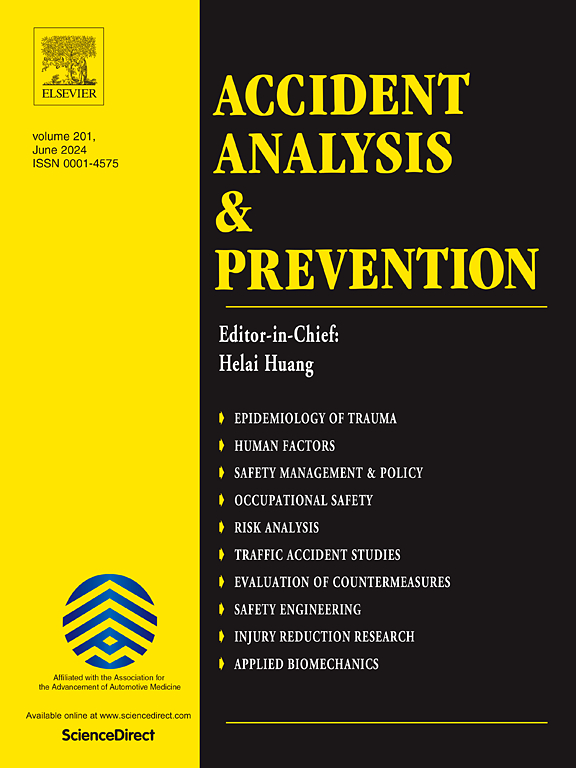基于改进的弱约束驾驶行为仿真平台的收费广场分流区安全性能分析
IF 6.2
1区 工程技术
Q1 ERGONOMICS
引用次数: 0
摘要
收费广场分流区是典型的非车道型高风险区域,其特点是交通交织频繁,车辆相互作用复杂。虽然基于观测的方法对于分析当前的安全状况是有效的,但它们在评估未来情景下基础设施设计和交通控制策略的安全影响方面缺乏灵活性。针对这一局限性,本研究提出了一种基于微仿真的方法,通过模拟不同交通条件下的现实冲突分布来分析收费广场分流区的安全性能。该方法基于感知-决策-行动(PDA)框架,通过对弱约束条件下的非车道感知、动态收费车道选择和车辆跟随等驾驶行为进行更精确的建模,提高了冲突仿真的精度。在两个不同的收费广场分流区的真实轨迹数据上验证,PDA方法模拟的冲突分布与观测数据非常吻合,而SUMO方法明显低估了分流区的安全风险。在此基础上,建立了基于PDA方法的仿真平台,定量分析了不同分流长度和交通量下收费广场分流区的安全性能。结果表明,分流长度不足会增加严重的冲突,而分流面积过长则会导致效率低下,没有实质性的安全效益。该研究为非车道区域的安全性能分析提供了新的见解,为优化复杂编织场景下的管理策略提供了可靠的模拟工具。本文章由计算机程序翻译,如有差异,请以英文原文为准。
Safety performance analysis of toll plaza diverging area based on an improved simulation platform for weak-constraint driving behaviors
Toll plaza diverging area is a typical non-lane-based high-risk area characterized by frequent weaving and complex vehicle interactions. While observation-based approaches are effective for analyzing current safety conditions, they lack the flexibility in evaluating the safety impacts of infrastructure designs and traffic control strategies under future scenarios. To address this limitation, this study proposes a microsimulation-based approach to analyze the safety performance of toll plaza diverging areas by simulating the realistic conflict distributions under various traffic conditions. Based on the perception-decision-action (PDA) framework, the proposed approach improves the conflict simulation accuracy by more accurately modeling the weak-constraint driving behavior, including non-lane-based perception, dynamic toll lane selection, and car-following under weak-constraint conditions. Validated on real-world trajectory data from two distinct toll plaza diverging areas, the simulated conflict distributions by the PDA approach closely align with the observed data, while SUMO significantly underestimates the safety risks in diverging areas. Furthermore, a simulation platform is developed based on the PDA approach to quantitatively analyze the safety performance of toll plaza diverging areas under different diverging lengths and traffic volumes. Results indicate that insufficient diverging lengths increase severe conflicts, whereas excessively long diverging areas lead to inefficiencies without substantial safety benefits. This study provides novel insights into safety performance analysis in non-lane-based areas, offering a reliable simulation tool for optimizing management strategies in complex weaving scenarios.
求助全文
通过发布文献求助,成功后即可免费获取论文全文。
去求助
来源期刊

Accident; analysis and prevention
Multiple-
CiteScore
11.90
自引率
16.90%
发文量
264
审稿时长
48 days
期刊介绍:
Accident Analysis & Prevention provides wide coverage of the general areas relating to accidental injury and damage, including the pre-injury and immediate post-injury phases. Published papers deal with medical, legal, economic, educational, behavioral, theoretical or empirical aspects of transportation accidents, as well as with accidents at other sites. Selected topics within the scope of the Journal may include: studies of human, environmental and vehicular factors influencing the occurrence, type and severity of accidents and injury; the design, implementation and evaluation of countermeasures; biomechanics of impact and human tolerance limits to injury; modelling and statistical analysis of accident data; policy, planning and decision-making in safety.
 求助内容:
求助内容: 应助结果提醒方式:
应助结果提醒方式:


